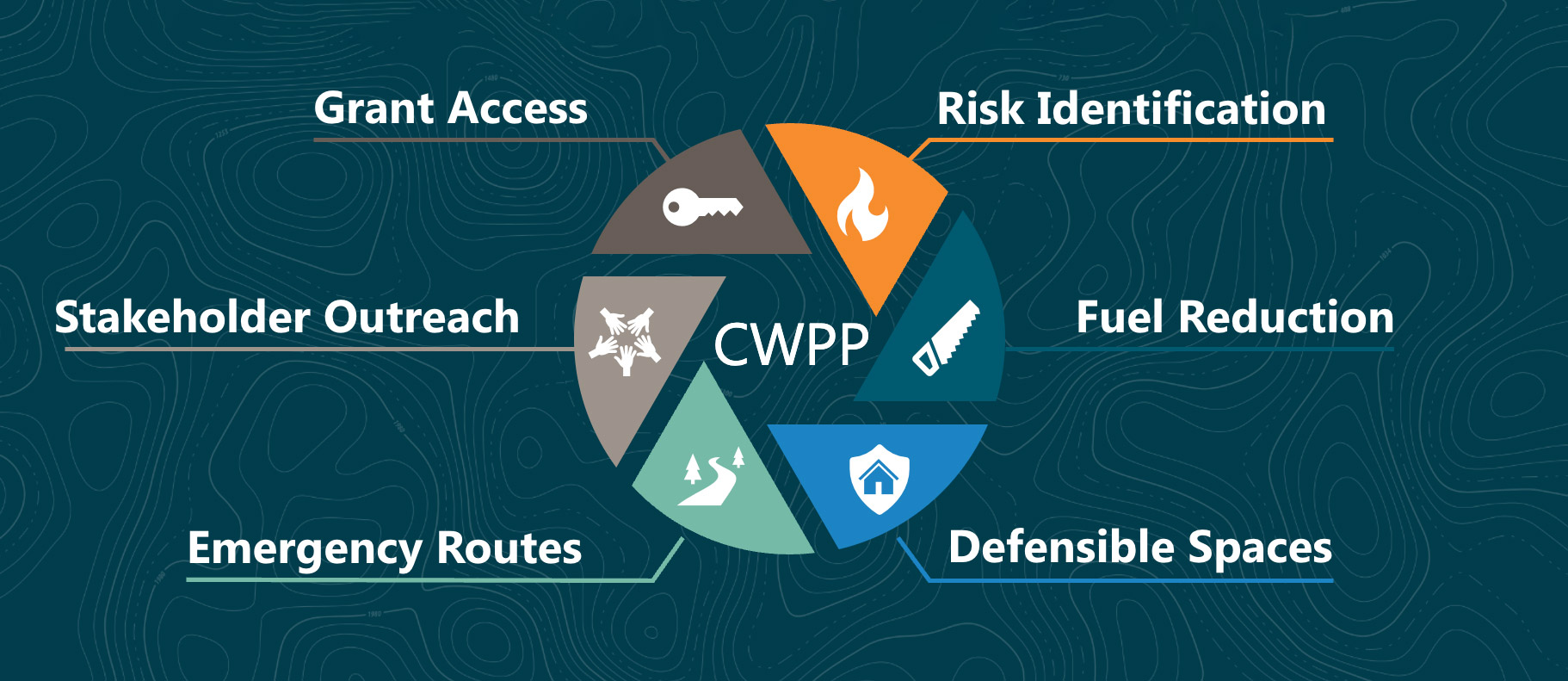Wildfire Mitigation Planning
CI International brings the experience, technical expertise, and national leadership in wildfire planning to help your community take action—before it’s too late. Our team includes former federal fire officials, wildfire risk assessors, and expert facilitators who have developed Community Wildfire Protection Plans, Emergency Services Strategic Plans, Forest Management Plans, Community Risk Assessments, and other guiding documents that meet federal standards and drive real, on-the-ground results.
We embed funding strategy into every plan—ensuring your CWPP is not only compliant, but also capable of unlocking the grants that turn planning into action. Partner with CI International and take the first—and most important—step toward a safer, more resilient future.
Your Community’s Wildfire Defense Plan
Wildfire risk across the United States is rising fast—and most communities are unprepared. With most at-risk areas lacking a Community Wildfire Protection Plan (CWPP), the window to act is closing. The final round of federal funding through the Community Wildfire Defense Grant (CWDG) is rapidly approaching, and without a CWPP, cities and counties are ineligible to apply. That’s not just a missed opportunity—it’s a costly liability. A CWPP is more than a plan on paper; it’s the foundation for securing federal dollars, implementing life-saving mitigation projects, and protecting what matters most.

A CWPP is a locally driven strategy that helps communities reduce wildfire risk and unlock critical funding. It’s the foundation for protecting lives, property, and natural resources.
A CWPP helps communities:
- Identify wildfire hazards and prioritize high-risk areas
- Plan fuel reduction projects and evacuation routes
- Coordinate with fire agencies and emergency services
- Qualify for state and federal wildfire mitigation grants
Without a CWPP, your community may be left unprotected—and unfunded.
OUR PROCESS
The Community Wildfire Protection Plan (CWPP) consulting methodology can be visualized as a step-by-step process that integrates stakeholder collaboration, risk analysis, planning, and implementation. Below is a concise outline of the overall process.

THE CI DIFFERENCE
Custom solutions specific to your community
We don’t deliver one-size-fits-all solutions. Instead, we collaborate with community leaders, emergency personnel, land managers, and residents to craft wildfire protection strategies grounded in local priorities and informed by best-available science.
A team of wildfire planning veterans and skilled facilitators
Our wildfire-risk experts guide public agencies, tribes, and communities through end-to-end mitigation: data-driven hazard assessments, Community Wildfire Protection Plan development, project-ready action plans, and grant-winning funding strategies—all designed to reduce fuel loads, protect critical assets, and build long-term resilience. We bring seasoned facilitators with in-depth wildfire experience to guide you through the process step-by-step.
Stakeholder and community prioritization
Through town halls, surveys, and workshops, we engage residents, landowners, and key partners to surface concerns and identify local priorities. We work toward consensus on priority areas for fuel reduction, home hardening, and emergency improvements—ensuring the plan reflects local knowledge and shared values.
Funding experts and Federal SME access
We assist organizations in developing their Community Wildfire Defense Grant (CWDG) grant applications for CWPP funding through strong relationships with foresters and community stakeholders. As we develop CWPPs, we help to identify eligible grants and opportunities to access additional funding needs. We help to maintain eligibility for grants by aligning with best practices and federal guidance to eliminate funding barriers.
High Impact, Low Cost
Our Plans Fund Themselves
10x
One grant can repay
your CCWP 10 times

Grant Writing

Fast Delivery

Built-in Efficiency
The CI International Wildfire Planning Team
CONTACT US
By phone:
By email:
Address:
2607 Francisco St.
Austin, TX 78702
Jeff Wyatt
is a seasoned fire service professional with over two decades of experience, culminating in retirement as an Air Force Fire Chief. He holds two master’s degrees from the University of Denver—one in Environmental Policy and Management and another in Leadership and Organizations—and a bachelor’s degree in Fire Emergency Services Administration from Colorado State University. Jeff has facilitated the creation of community and WUI (Wildland Urban Interface) risk assessments for fire departments across the nation and has taught advanced concepts in community risk reduction. He excels at guiding committees and agencies toward strategic planning, ensuring all stakeholders understand how to mitigate wildfire threats effectively. Jeff’s leadership style is grounded in fostering data-driven decisions, enhancing interagency collaboration, and delivering resilient outcomes for communities.
Tim Eichner
is a seasoned GIS specialist and natural resources professional with over two decades of experience in geospatial technology, wildfire response, and water resource management. A professor at Flathead Valley Community College since 2012, he has developed and led courses in forestry and geospatial technology while spearheading a certificate program in geospatial technology. Tim also serves as a lead GIS Specialist for a Northern Rockies Complex Incident Management Team, where he provides spatial analysis and mapping support for wildfire incidents. Tim is known for his collaborative approach, problem-solving mindset, and passion for applying geospatial tools to real-world natural resource challenges.
Brian Ferebee
retired from the U.S. Forest Service in March 2025 after 36 years in the federal government, where he served most recently as the agency’s lead on wildfire crisis strategy and was responsible for developing and implementing a 10-year Wildfire Risk Reduction Plan. As Chief Executive of Intergovernmental Relations, Brian worked nationwide with County Commissioners and other local government representatives to enhance the relationship between the federal government and local governments. As Regional Forester for the Rocky Mountain Region, Brian was the lead administrator for National Forests and Grasslands in Colorado, Wyoming, Nebraska, South Dakota, and Kansas. Prior to that position, he served as Deputy Regional Forester for the Rocky Mountain Region, Forest Supervisor on the Uinta-Wasatch-Cache NF, Forest Supervisor on the Uinta NF, and Deputy Forest Supervisor on the Pike San Isabel National Forest.
Kimberly Lightley
brings a powerful combination of technical expertise, field experience, and personal insight into wildfire risk management. As a surviving crewmember of the South Canyon Fire on Storm King Mountain, her perspective is deeply personal, she understands the stakes and channels that experience into every plan she supports. Kimberly began her career fighting wildland fires on engine crews and elite hotshot teams, gaining firsthand knowledge of safety and mitigation in action. She later served as a Risk Management Program Specialist for the USDA Forest Service Washington Office, where she shaped national strategies to protect people and resources. Today, she partners with agencies at all levels to deliver strategic assessments and guide the development of actionable, community-rooted CWPPs. Her credibility, compassion, and commitment make her a trusted ally in building wildfire resilience. Kimberly holds a Master of Science in Risk Management from Notre Dame of Maryland University and a Bachelor of Science in Biology from George Fox University.
Gary Bettger
is a seasoned facilitator with in-depth experience in the land management arena. He has provided extensive facilitation to the USDA Forest Service, particularly Fire & Aviation Management, including the Complex Incident Mgt (CIM) After Action Review (AAR), with over a hundred different stakeholders from USDA, DOI, and beyond. He also supports the California Fire Safe Council in program evaluation/impact assessment. He is certified Project Management Professional and adjunct professor at George Mason University, where he teaches program evaluation. He is a former strategic planning practice leader at Booz Allen Hamilton.
Fred Richardson
is a principal at CI International with over 25 years of experience in the management consulting sector. He is a certified facilitator with lengthy experience working with non-profit communities in the land management arena. While at Booz Allen Hamilton, Fred served as project manager for the 2013-2014 Quadrennial Fire Review, a federal interagency effort to develop a 20-year forecast for the future of wildland fire in the United States. He acts as CI International’s account manager for business with the USDA Forest Service’s Fire & Aviation Management directorate. He holds a master’s degree from the LBJ School of Public Affairs at the University of Texas.
Dragobert Sharp
has 35 years of experience in wildland fire and land management, most recently serving as a Program Manager for Fire & Aviation Management in the USDA Forest Service. His career began on the frontlines as a wildland firefighter and evolved through leadership roles including Interagency Hotshot Crew Foreman, Forest Fire Management Officer, Coordination Center Manager, Acting Forest Fire & Lands Staff Officer, and Strategic Planner for Fire and Aviation Management.
Throughout his tenure with the Forest Service he worked on interdisciplinary teams and collaborated with communities and partners nationwide. His accomplishments include developing Community Wildfire Protection Plans, advancing Firewise communities through partnerships with local leaders and residents, and managing the National Cohesive
Strategy Project. As a Contracting Officer Representative (COR) he oversaw a wide range of projects supporting operational readiness, workforce development, and technical innovation across State, Private, and Tribal Forestry programs. He attended Prairie View A&M University, a Land Grant Institution in Texas. As an avid leaner he continued his education with specialized training in fuels management and geospatial technology from institutions including Mississippi State, Utah State, and Colorado State Universities.
